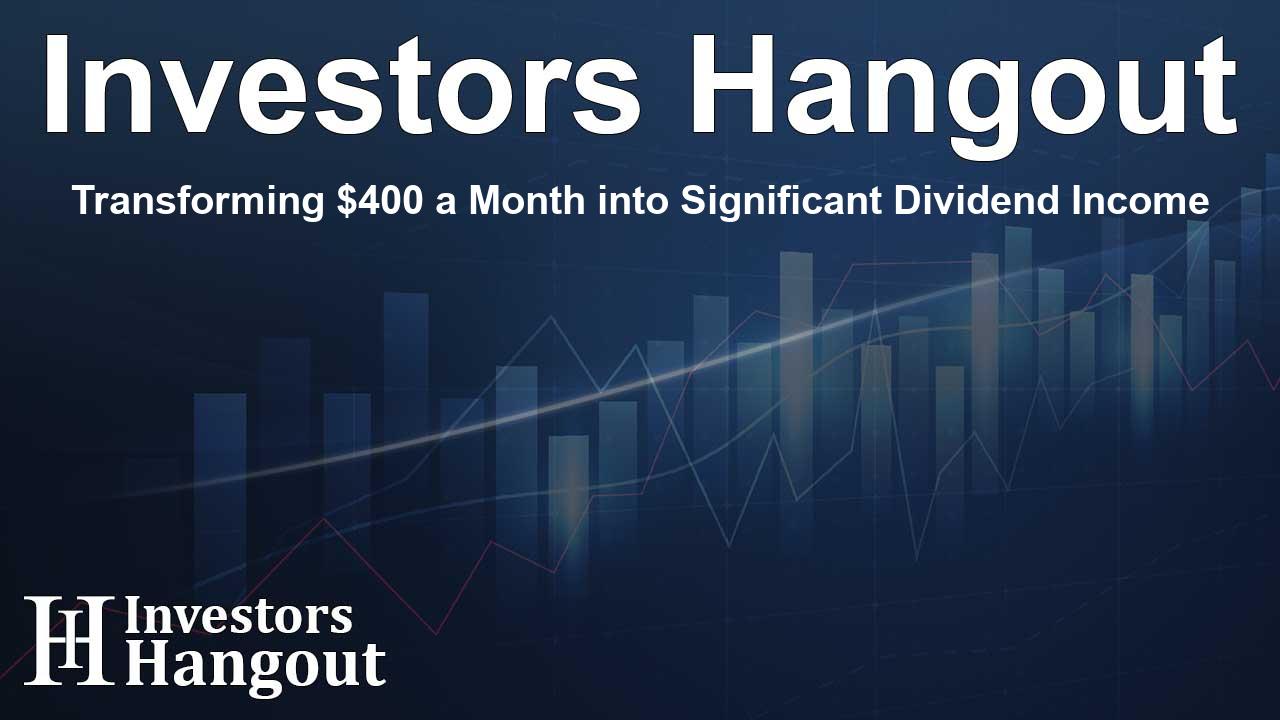Transforming $400 a Month into Significant Dividend Income

Maximizing Your Investment: A Strategic Guide
The S&P 500 has outperformed various asset classes over the last decade, making it an attractive choice for investors seeking robust returns. It’s noteworthy that S&P 500 index funds have consistently delivered better returns compared to many large-cap funds, highlighting their potential for portfolio growth.
Utilizing this information allows investors to create a portfolio aimed at generating passive income. For example, investing $400 monthly into an S&P 500 index fund could grow to a substantial $789,500 over thirty years. This sum could subsequently be reinvested in a high dividend yield index fund, providing an estimated $16,800 in annual passive income.
Let's explore the essential steps to achieve these financial goals.
Step 1: Commence with Vanguard S&P 500 ETF Investment
The Vanguard S&P 500 ETF is a cost-effective option for exposure to the S&P 500 index. This fund reflects the performance of 500 U.S. companies, offering investors a diversified approach that covers around 80% of internal equities and over 50% globally by market capitalization. It provides a practical way to invest across many of the most impactful businesses globally.
Here are the five top holdings in the Vanguard S&P 500 ETF based on weight:
Apple: 6.9%
Microsoft: 6.5%
Nvidia: 6.2%
Alphabet: 3.7%
Amazon: 3.4%
Over the past thirty years, the S&P 500 has returned approximately 2,000%, averaging 10.6% annually. With a conservative approach, rounding down to 10%, investing $400 monthly could yield an impressive $789,500 after thirty years. Investors could then consider reallocating these funds into a different index fund.
However, be aware that depending on your investment account type, selling the Vanguard S&P 500 ETF could trigger capital gains tax. Anticipating various tax implications, the total tax burden might approximate $150,000, leaving $639,500 available to reinvest into a high dividend yield index fund.
Step 2: Allocate $639,500 into Vanguard High Dividend Yield ETF
The Vanguard High Dividend Yield ETF focuses on U.S. companies expected to deliver above-average dividends. In contrast to the broader S&P 500 coverage, this fund places a strong emphasis on value stocks. Here are its five largest holdings:
Broadcom: 4.2%
JPMorgan Chase: 3.6%
ExxonMobil: 3%
Procter & Gamble: 2.3%
Johnson & Johnson: 2.2%
Currently, this ETF provides a dividend yield of 2.63%. Thus, investing the $639,500 could generate roughly $16,800 in annual dividend income, with the possibility of increased payouts over time.
Over the last decade, this ETF has achieved a return of 88%, suggesting significant growth potential over a ten-year frame, ultimately approaching $1.2 million, facilitating an annual dividend income of approximately $31,600.
Emphasizing Higher Savings for a Secure Future
According to recent data, the median American worker has earned an after-tax income of $69,240 in the past year. Financial experts typically recommend saving 20% of one’s after-tax income for retirement, translating to about $13,848 annually or $1,154 per month for the average worker.
In this light, a monthly saving goal of $400 can be feasible for many. This approach leaves about $754 per month for additional investments in various stocks or index funds, ultimately contributing to a substantial retirement nest egg, potentially generating considerable passive income.
Is Now the Right Time to Invest?
When contemplating an investment in Vanguard S&P 500 ETF, it’s important to consider expert recommendations and the current market landscape. Recent insights highlight that top-performing stocks in the market may present promising alternative investment opportunities.
As market conditions fluctuate, evaluating your options is essential for successful investing. Consider the potential of various stocks before making financial commitments.
Frequently Asked Questions
What are the benefits of investing in the Vanguard S&P 500 ETF?
The Vanguard S&P 500 ETF provides diversified exposure to large-cap U.S. companies, offering potential for robust long-term growth and competitive returns compared to traditional funds.
How much could I expect to earn from passive income through index funds?
If you invest strategically, you could see significant annual passive income. Specifically, investing $400 monthly could lead to approximately $16,800 in annual dividends, depending on market conditions and fund performance.
What is a high dividend yield ETF?
A high dividend yield ETF focuses on companies that are expected to pay above-average dividends. This type of investment is aimed at generating reliable income for investors.
Are there tax implications when selling an ETF?
Yes, selling an ETF like Vanguard S&P 500 can incur capital gains tax, which varies based on the investment account type and the gains realized from the sale.
How can I ensure my investments grow over time?
Regular contributions, diversification of your portfolio, and strategic investment choices are key factors that can enhance growth and build a reliable source of passive income over time.
About The Author
Contact Caleb Price privately here. Or send an email with ATTN: Caleb Price as the subject to contact@investorshangout.com.
About Investors Hangout
Investors Hangout is a leading online stock forum for financial discussion and learning, offering a wide range of free tools and resources. It draws in traders of all levels, who exchange market knowledge, investigate trading tactics, and keep an eye on industry developments in real time. Featuring financial articles, stock message boards, quotes, charts, company profiles, and live news updates. Through cooperative learning and a wealth of informational resources, it helps users from novices creating their first portfolios to experts honing their techniques. Join Investors Hangout today: https://investorshangout.com/
The content of this article is based on factual, publicly available information and does not represent legal, financial, or investment advice. Investors Hangout does not offer financial advice, and the author is not a licensed financial advisor. Consult a qualified advisor before making any financial or investment decisions based on this article. This article should not be considered advice to purchase, sell, or hold any securities or other investments. If any of the material provided here is inaccurate, please contact us for corrections.
